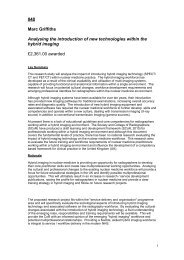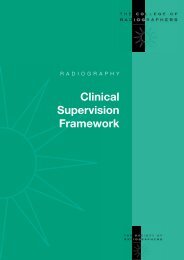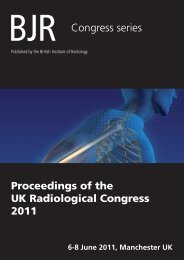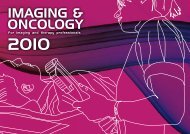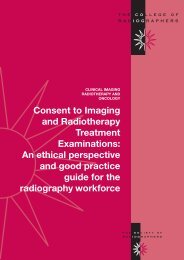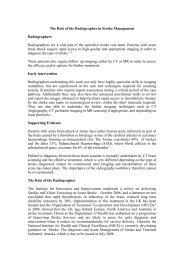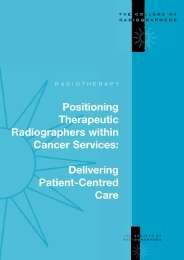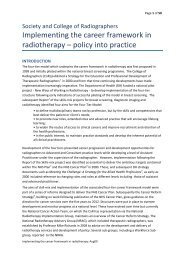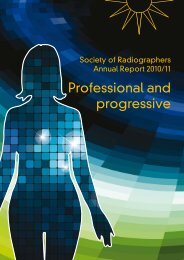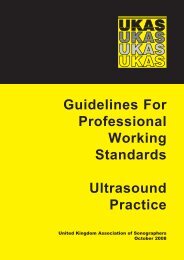Medical Image Interpretation by Radiographers: Definitive Guidance
Medical Image Interpretation by Radiographers: Definitive Guidance
Medical Image Interpretation by Radiographers: Definitive Guidance
You also want an ePaper? Increase the reach of your titles
YUMPU automatically turns print PDFs into web optimized ePapers that Google loves.
<strong>Medical</strong> <strong>Image</strong> <strong>Interpretation</strong> <strong>by</strong> <strong>Radiographers</strong>:<br />
<strong>Definitive</strong> <strong>Guidance</strong><br />
The Society and College of <strong>Radiographers</strong><br />
Introduction<br />
Advice on radiographers’ practice entitled <strong>Medical</strong> image interpretation <strong>by</strong> radiographers:<br />
<strong>Guidance</strong> for radiologists and healthcare providers has been issued recently <strong>by</strong> the Royal College<br />
of Radiologists (RCR) 1 . This outlines the RCR’s view on the conditions under which radiographers<br />
can undertake medical image reporting. The RCR’s guidance infers there are substantial risks for<br />
healthcare organisations in using professionals without medical qualifi cations to undertake medical<br />
image reporting, claiming that radiological diagnosis is included within the practice of medicine. It<br />
confi nes its guidance to radiographers only, taking no account of the fact that other non-medically<br />
qualifi ed groups also undertake medical image interpretation, including for example, nurse<br />
practitioners, midwives and physiotherapists 2,3,4 .<br />
The Society and College of <strong>Radiographers</strong> perspective<br />
The RCR is not the body that speaks for the radiography profession and it has no role in<br />
determining what is or is not appropriate practice for radiographers.<br />
The Society and College of <strong>Radiographers</strong> (SCoR) regrets that the RCR has issued its advice<br />
document on the practice of radiographers for several reasons:<br />
• <strong>Medical</strong> image interpretation <strong>by</strong> radiographers is well established 5 , with forty years of such<br />
practice in medical ultrasound imaging and twenty years in other fi elds of medical imaging.<br />
• The legal impediment to radiographers carrying out medical image interpretation was<br />
removed in the mid 1980s <strong>by</strong> the (then) statutory body for the radiography profession, the<br />
<strong>Radiographers</strong> Board at the Council for Professions Supplementary to Medicine 6 . The RCR<br />
held a seat on that Board and so was party to that decision.<br />
• In the past two decades, the contribution of radiographers to medical image interpretation has<br />
improved the volume of reporting undertaken and the speed at which reports are provided<br />
(report turn-around times), to the benefi t of referrers and patients alike 7 .<br />
• Research studies show consistently that reports made <strong>by</strong> properly trained reporting<br />
radiographers are concordant with reports of consultant radiologists, and are more accurate<br />
than those of non-radiological medical staff and other non-medical professionals 8-10 .<br />
• The description of radiographers’ education and training in medical image interpretation is<br />
both inaccurate and out of date.<br />
• The provision of defi nitive guidance on the practice of radiographers is the duty of the SCoR.<br />
In 2006, we issued our guidance 11 on reporting <strong>by</strong> radiographers in the document <strong>Medical</strong><br />
<strong>Image</strong> <strong>Interpretation</strong> & Clinical Reporting <strong>by</strong> Non-Radiologists: The Role of the Radiographer.<br />
The SCoR believes that the guidance issued <strong>by</strong> the RCR damages confi dence in the quality<br />
of clinical imaging services as they have been provided over many years, and may undermine<br />
future service development. Our view is that advanced practice radiographers are crucial to<br />
overcoming the challenges facing clinical imaging services in the future and, as the professional<br />
body responsible for the scope of practice of radiographers, we are publishing this document<br />
to provide assurance to healthcare providers that radiographer reporting is safe, subject to<br />
reporting radiographers and their employers/contractors, adhering to the guidance and standards<br />
of the SCoR 11-13 . Healthcare organisations need to deliver effective, timely clinical imaging and<br />
interventional services, and radiographers, including advanced and consultant practice reporting<br />
radiographers, are essential to doing so.<br />
6






